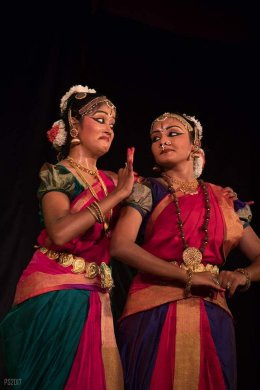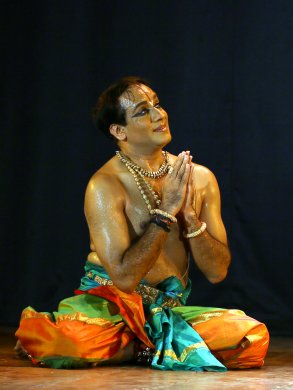
|   |

|   |
Shower of bliss at Nrithya Varsha - Sumangala Rathnakar January 29, 2018 'Nrithya Varsha' was organised jointly by Gaana Nrithya Academy and Arehole Pratishthana at Don Bosco Hall in Mangalore. It was a treat to watch two young budding performers, Shwetha Areole and Vaishnavi Bhat from Mangalore and veteran Sathyanarayana Raju, Bengaluru. Shwetha and Vaishnavi, disciples of Vidyashree Radhakrishna, Director of Gaana Nrithya Academy, presented a creative and intricate thematic performance based on the contrasting and conjoining Hari-Hara. They commenced the evening with "Hariharanjali" in ragamalika and talamalika, invoking the blessings of Hari and Hara with swara, sollukattu and shloka giving a glimpse of their nritta and abhinaya. The evening continued in Kharaharapriya raga and adi tala with 'Hari-Hara Varnam' with devotion at its centre. Composed in Kannada, it began with the lines "Aadhaaranu neene, Harinarayana, Atirudranu neene, Harashankara" representing the contrasting character of the lords, Hari being the composed and the foundation of the entire life system and Hara being the maintainer of delight through destruction of the evil. Our mythology, our Daasa sahitya, Puranas are filled with instances that prove time and again that Hari and Hara are manifestations of the one divine power and through all their variances they represent the One! This varnam was yet another representation of this interpretation. The highlight of the varnam was the lyrics of the charana which said "Raktiye viraktiye supta chittanandake?" which brings out a hint of dilemma in the mind of the devotee as to what is the path leading to the lords and concludes with the idea that they are neither separate nor distinct, they have always been 'One' giving an important message of unity in the times where we commoners stand divided in the name of our gods. The first ever attempt at composing the song made by Guru Vidyashree was indeed commendable and the music composition of Swarag Kannur brought the song to life. "Tarale Ranne" of Purandaradasa brought out a slightly different form of describing the profound lords. With the music composition of G Srikanth, Chennai, it was set in ragamalika, adi tala where the goddesses Parvati and Lakshmi get into mockery of each other's husbands. The abhinaya here was beautiful and heart warming and the conclusion of respecting each other's shortcomings and upholding the greatness united all the minds in the audience. These young dancers placed another foot forward in their dance journey towards a bright future. Their Guru Vidyashree Radhakrishna lifted the program with her melodious singing, Tanya Shetty supported in nattuvangam, Geetesh Kanhangad on mridangam and Sridhar Acharya on the violin.  Shwetha Areole and Vaishnavi Bhat  Sathyanarayana Raju The second half of the program featured Sathyanarayana Raju, who won the hearts of the audience with his impeccable orchestra and his overwhelming abhinaya in 'Ramakatha.' Curated by Usha R K from Delhi, this presentation had many famous composers' literature beautifully woven into the story line of Ramayana depicting various characters and episodes in an extremely convincing manner. Sathyanarayana invoked the blessings of Sri Rama by offering his salutations to a saffron shawl symbolising the greatness of Rama's weapon, the bow and arrow, and his sacrifices to the words of Tyagaraja's "Melukovayya" in Bouli raga and khanda chapu tala. Depicting the episodes of the birth of the lord, his childhood, his character etc, he continued the program with Tulsidas's "Thumak chalat Ramachandra" in Hindustani Kaapi raga and trishra eka tala. For the lyrics of "Pattabhisheka Velalo", the sequence of Ahalyodhara and Seeta kalyana was brilliantly portrayed. The song took turn into Shivaranjani raga from Abheri for the episode of Kaikeyi-Manthara conversation. It was extraordinary, the way Sathyanarayana took on the role through aharya and satwa by draping the saree on the stage in his performance and slowly transforming into Manthara. The pained silence of Dasharatha as he confronted Kaikeyi was ringing too loud in the hearts of the audience. Going forward, Shabari through him brought tears in the eyes of the spectators for "Bhajaman Ramacharan" song of Suradas. In the "Hanumanta deva namo" of Purandaradasa, he depicted the entire story line of Rama-Hanuman from their very first meeting until the Lanka-dahana. It continued with "Alli nodalu Rama" where the Ravana vadha episode was brought in which spread the vibes of victory and valour. From the peak of emotions, Sathyanarana brought the audience to composure with his concluding tillana in Sumanasaranjani raga, where Sri Rama became Lord Rama and looked after his kingdom with such greatness that it became a beacon of administration for the centuries to come. On the orchestra was the renowned D.S. Srivatsa, who added life to all the characters of Ramakatha with his vocals, Shakuntala Prabhat on nattuvangam, Lingaraju on mridangam, Raghunandan on flute and lighting support by Naveen M.G. Ramakatha served a full course 'rasasvada' for the audience. Sumangala Rathnakar is a professional Bharatanatyam artiste and critic. |